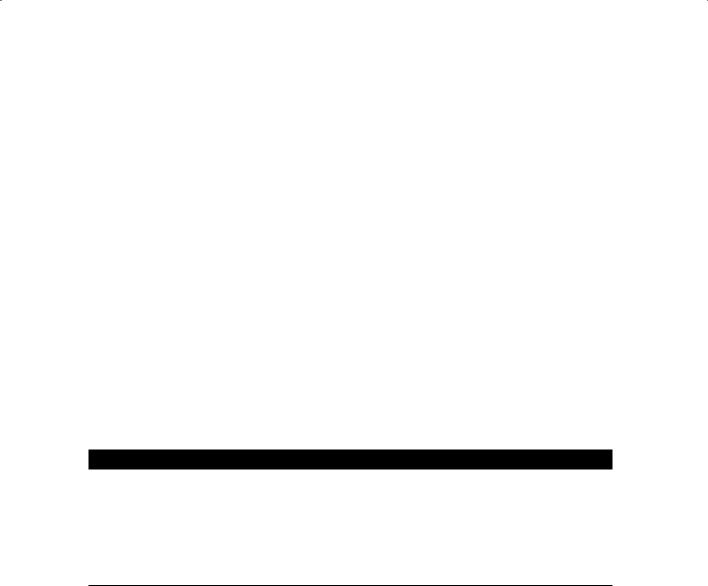
- •Acknowledgments
- •About the Author
- •Contents at a Glance
- •Contents
- •Table of Exercises
- •Introduction
- •Assessment Test
- •Answers to Assessment Test
- •Defining Ethical Hacking
- •How to Be Ethical
- •Keeping It Legal
- •Summary
- •Exam Essentials
- •Review Questions
- •Answers to Review Questions
- •Reconnaissance
- •Information-Gathering Methodology
- •Social Engineering
- •Summary
- •Exam Essentials
- •Review Questions
- •Answers to Review Questions
- •Scanning
- •Enumeration
- •Summary
- •Exam Essentials
- •Review Questions
- •Answers to Review Questions
- •The Simplest Way to Get a Password
- •Types of Passwords
- •Cracking a Password
- •Understanding Keyloggers and Other Spyware Technologies
- •Escalating Privileges
- •Understanding Rootkits
- •Hiding Files
- •Understanding Steganography Technologies
- •Summary
- •Exam Essentials
- •Review Questions
- •Answers to Review Questions
- •Trojans and Backdoors
- •Viruses and Worms
- •Summary
- •Exam Essentials
- •Review Questions
- •Answers to Review Questions
- •How a Sniffer Works
- •Sniffing Countermeasures
- •Bypassing the Limitations of Switches
- •Wireshark Filters
- •Summary
- •Exam Essentials
- •Review Questions
- •Answers to Review Questions
- •Denial of Service
- •Session Hijacking
- •Summary
- •Exam Essentials
- •Review Questions
- •Answers to Review Questions
- •How Web Servers Work
- •Types of Web Server Vulnerabilities
- •Web Application Vulnerabilities
- •Summary
- •Exam Essentials
- •Review Questions
- •Answers to Review Questions
- •SQL Injection
- •Buffer Overflows
- •Summary
- •Exam Essentials
- •Review Questions
- •Answers to Review Questions
- •Wi-Fi and Ethernet
- •Authentication and Cracking Techniques
- •Using Wireless Sniffers to Locate SSIDs
- •MAC Filters and MAC Spoofing
- •Rogue Access Points
- •Wireless Hacking Techniques
- •Securing Wireless Networks
- •Summary
- •Exam Essentials
- •Review Questions
- •Answers to Review Questions
- •Components of Physical Security
- •Understanding Physical Security
- •Physical Site Security Countermeasures
- •What to Do After a Security Breach Occurs
- •Summary
- •Exam Essentials
- •Review Questions
- •Answers to Review Questions
- •Linux Basics
- •Compiling a Linux Kernel
- •GCC Compilation Commands
- •Installing Linux Kernel Modules
- •Linux Hardening Methods
- •Summary
- •Exam Essentials
- •Review Questions
- •Answers to Review Questions
- •Types of IDSs and Evasion Techniques
- •Summary
- •Exam Essentials
- •Review Questions
- •Answers to Review Questions
- •Generating Public and Private Keys
- •Cryptography Algorithms
- •Summary
- •Exam Essentials
- •Review Questions
- •Answers to Review Questions
- •Defining Security Assessments
- •Penetration Testing
- •Pen Test Deliverables
- •Summary
- •Exam Essentials
- •Review Questions
- •Answers to Review Questions
- •Glossary
- •Index

Viruses and Worms |
141 |
E x e r c i s e 5 . 2 ( c o n t i n u e d )
7.Click the View Log button to see the report.
System File Checker is another command line–based tool used to check whether a Trojan program has replaced files. If System File Checker detects that a file has been overwritten, it retrieves a known good file from the Windows\system32\dllcache folder and overwrites the unverified file. The command to run the System File Checker is sfc/scannow.
Viruses and Worms
Viruses and worms can be used to infect a system and modify a system to allow a hacker to gain access. Many viruses and worms carry Trojans and backdoors. In this way, a virus or worm is a carrier and allows malicious code such as Trojans and backdoors to be transferred from system to system much in the way that contact between people allows germs to spread.
A virus and a worm are similar in that they’re both forms of malicious software (malware). A virus infects another executable and uses this carrier program to spread itself. The virus code is injected into the previously benign program and is spread when the program is run. Examples of virus carrier programs are macros, games, email attachments, Visual Basic scripts, and animations.
A worm is similar to a virus in many ways but does not need a carrier program. A worm can self-replicate and move from infected host to another host. A worm spreads

142 Chapter 5 n Trojans, Backdoors, Viruses, and Worms
from system to system automatically, but a virus needs another program in order to spread. Viruses and worms both execute without the knowledge or desire of the end user.
Types of Viruses
Viruses are classified according to two factors: what they infect and how they infect. A virus can infect the following components of a system:
NN |
System sectors |
NN |
Files |
NN |
Macros (such as Microsoft Word macros) |
|
|
NN |
Companion files (supporting system files like DLL and INI files) |
NN |
Disk clusters |
NN |
Batch files (BAT files) |
|
|
NN |
Source code |
|
A virus infects through interaction with an outside system. Viruses need to be carried by another executable program. By attaching itself to the benign executable a virus can spread fairly quickly as users or the system runs the executable. Viruses are categorized according to their infection technique, as follows:
Polymorphic Viruses These viruses encrypt the code in a different way with each infection and can change to different forms to try to evade detection.
Stealth Viruses These viruses hide the normal virus characteristics, such as modifying the original time and date stamp of the file so as to prevent the virus from being noticed as a new file on the system.
Fast and Slow Infectors These viruses can evade detection by infecting very quickly or very slowly. This can sometimes allow the program to infect a system without detection by an antivirus program.
Sparse Infectors These viruses infect only a few systems or applications. Armored Viruses These viruses are encrypted to prevent detection. Multipartite Viruses These advanced viruses create multiple infections. Cavity (Space-Filler) Viruses These viruses attach to empty areas of files.
Tunneling Viruses These viruses are sent via a different protocol or encrypted to prevent detection or allow it to pass through a firewall.
Camouflage Viruses These viruses appear to be another program.
NTFS and Active Directory Viruses These viruses specifically attack the NT file system or Active Directory on Windows systems.

Viruses and Worms |
143 |
An attacker can write a custom script or virus that won’t be detected by antivirus programs. Because virus detection and removal is based on a signature of the program, a hacker just needs to change the signature or look of the virus to prevent detection. The virus signature or definition is the way an antivirus program is able to determine if a system is infected by a virus. Until the virus is detected and antivirus companies have a chance to update virus definitions, the virus goes undetected. Additional time may elapse before a user updates the antivirus program, allowing the system to be vulnerable to an infection. This allows an attacker to evade antivirus detection and removal for a period of time. A critical countermeasure to virus infection is to maintain up-to-date virus definitions in an antivirus program.
One of the most longstanding viruses was the Melissa virus, which spread through Microsoft Word Macros. Melissa infected many users by attaching to the Word doc and then when the file was copied or emailed, the virus spread along with the file.
Virus Hoaxes are emails sent to users usually with a warning about a virus attack. The Virus Hoax emails usually make outlandish claims about the damage that will be caused by a virus and then offer to download a remediation patch from well-known companies such as Microsoft or Norton. Other Hoaxes recommend users delete certain critical systems files in order to remove the virus. Of course, should a user follow these recommendations they will most certainly have negative consequences. Some of the most common virus hoaxes are shown in Table 5.1:
Ta b l e 5 .1 Common Virus Hoaxes
Name |
Executable |
Description |
|
|
|
Antichrist |
(none) |
This is a hoax that warned about a supposed |
|
|
virus discovered by Microsoft and McAfee |
|
|
named “Antichrist”, telling the user that it is |
|
|
installed via an email with the subject line: “SUR- |
|
|
PRISE?!!!!!!!!!!” after which it destroys the zeroth |
|
|
sector of the hard disk, rendering it unusable. |
Budweiser Frogs |
BUDSAVER.EXE |
Supposedly would erase the user’s hard drive and |
|
|
steal the user’s screen name and password. |
Goodtimes virus |
(none) |
Warnings about a computer virus named “Good |
|
|
Times” began being passed around among Internet |
|
|
users in 1994. The Goodtimes virus was suppos- |
|
|
edly transmitted via an email bearing the subject |
|
|
header “Good Times” or “Goodtimes,” hence the |
|
|
virus’s name, and the warning recommended delet- |
|
|
ing any such email unread. The virus described in |
|
|
the warnings did not exist, but the warnings them- |
|
|
selves, were, in effect, virus-like. |

144 |
Chapter 5 n Trojans, Backdoors, Viruses, and Worms |
|||
Ta b l e |
5 .1 Common |
Virus Hoaxes (continued) |
||
|
|
|
|
|
Name |
|
Executable |
Description |
|
|
|
|
|
|
Invitation |
|
Allright now/ |
The invitation virus hoax involved an email spam |
|
attachment |
I’m just sayin |
in 2006 that advised computer users to delete an |
||
(computer |
|
|
email, with any type of attachment that stated |
|
virus hoax) |
|
|
“invitation” because it was a computer virus. |
|
Jdbgmgr.exe |
bear.a |
|
The jdbgmgr.exe virus hoax involved an email |
|
|
|
|
|
spam in 2002 that advised computer users to |
|
|
|
|
delete a file named jdbgmgr.exe because it was |
|
|
|
|
a computer virus. jdbgmgr.exe, which had a |
|
|
|
|
little teddy bear-like icon (The Microsoft Bear), |
|
|
|
|
was actually a valid Microsoft Windows file, the |
|
|
|
|
Debugger Registrar for Java (also known as Java |
|
|
|
|
Debug Manager, hence jdbgmgr). |
Life is beautiful |
Life is wonderful |
The hoax was spread through the Internet around |
||
|
|
|
|
January 2001 in Brazil. It told of a virus attached |
|
|
|
|
to an email, which was spread around the Inter- |
|
|
|
|
net. The attached file was supposedly called “Life |
|
|
|
|
is beautiful.pps” or “La vita è bella.pps”. |
Olympic Torch |
Postcard or |
Olympic Torch is a computer virus hoax sent out |
||
|
|
Postcard from |
by email. The hoax emails first appeared in Feb- |
|
|
|
Hallmark |
ruary 2006. The “virus” referred to by the email |
|
|
|
|
|
does not actually exist. The hoax email warns |
|
|
|
|
recipients of a recent outbreak of “Olympic Torch” |
|
|
|
|
viruses, contained in emails titled “Invitation,” |
|
|
|
|
which erase the hard disk of the user’s computer |
|
|
|
|
when opened. |
SULFNBK.EXE |
none |
|
SULFNBK.EXE (short for Setup Utility for Long |
|
Warning |
|
|
|
File Name Backup) is an internal component of the |
|
|
|
|
Microsoft Windows operating system (in Windows |
|
|
|
|
98 and Windows Me) for restoring long file names. |
|
|
|
|
The component became famous in the early 2000s |
|
|
|
|
as the subject of an email hoax. The hoax claimed |
|
|
|
|
that SULFNBK.EXE was a virus, and contained |
instructions to locate and delete the file. While the instructions worked, they were needless and (in some rare cases, for example, when the long file names are damaged and need to be restored) can cause disruptions, as SULFNBK.EXE is not a virus, but instead an operating system component.

Viruses and Worms |
145 |
To find out whether an email regarding a virus is legitimate, review the list of virus hoaxes on the website home.mcafee.com/virusinfo.
Virus Detection Methods
The following techniques are used to detect viruses:
NN |
Scanning |
|
|
NN |
Integrity checking with checksums |
NN |
Interception based on a virus signature |
|
The process of virus detection and removal is as follows:
1.Detect the attack as a virus. Not all anomalous behavior can be attributed to a virus.
2.Trace processes using utilities such as handle.exe, listdlls.exe, fport.exe, netstat.exe, and pslist.exe, and map commonalities between affected systems.
3.Detect the virus payload by looking for altered, replaced, or deleted files. New files, changed file attributes, or shared library files should be checked.
4.Acquire the infection vector and isolate it. Then, update your antivirus definitions and rescan all systems.
In Exercise 5.3, we will create a test virus.
E x e r c i s e 5 . 3
Creating a Test Virus
A test virus can be created by typing the following code in Notepad and saving the file as EICAR.COM. Your antivirus program should respond when you attempt to open, run, or copy it.
X5O!P%@AP[4\PZX54(P^)7CC)7}$EICAR-STANDARD-ANTIVIRUS-TEST-FILE!$H+H*
Worms can be prevented from infecting systems in much the same way as viruses. Worms can be more difficult to stop because they spread on their own, meaning they do not need user intervention to install and continue to propagate the malware. Worms can be detected with the use of antimalware software that contains definitions for worms. Worms, most importantly, need to be stopped from spreading. In order to do this, an administrator may need to take systems off line. The best practice for cleaning worms off networked systems is to first remove the computer from the network and then run the security software to clean the worm.
